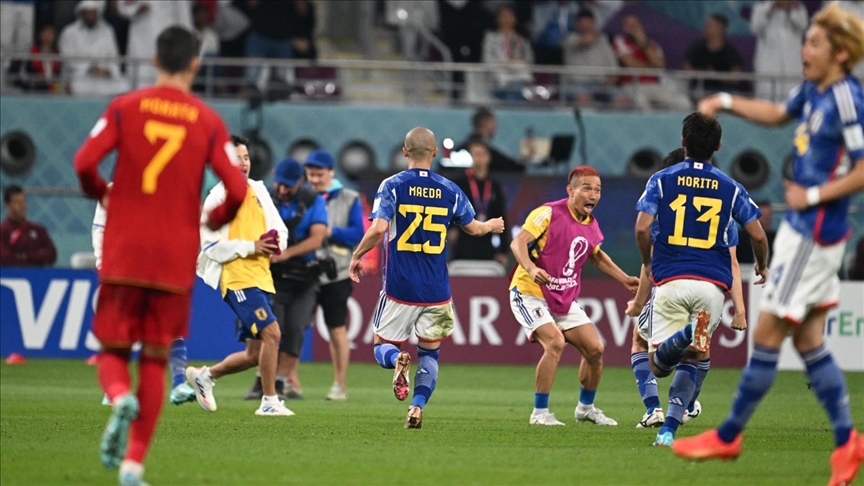ISTANBUL
When thinking of Japan’s presence at the 2022 World Cup, only two things come to mind for international football fans: the group of Japanese fans picking up rubbish in the stands and some unexpected performances from little known Japanese players.
But the tournament will also be remembered for Japan’s historic performance in the group stages with remarkable wins against world champions Germany and Spain, reaching the Round of 16 as Group E leaders with six points under the management of Hajime Moriyasu. This was despite the team’s shock 1-0 loss to Costa Rica in a group match they dominated, but failed to score.
Although Japan failed to achieve their dream of advancing to the quarter-finals after losing 3-1 to Croatia on penalties in the Round of 16, the team’s brave performance in Qatar proved that the gap between Japan and European football is closing in.
Speaking to Anadolu Agency in an email interview, Dan Orlowitz, a sports journalist at The Japan Times newspaper, said the victories against Germany and Spain showed Japan’s capability of stepping up at the World Cup rather than hoping for a favorable draw.
Japan is the world’s third-biggest economy, with a population of over 125 million, but the national football team did not see any remarkable success until the 1990s.
Since then, however, they have become four-time Asian champions and have booked their World Cup spot the seventh consecutive time.
Asked what has changed since Japan’s first World Cup in 1998, Orlowitz said they now have more players playing in Europe, or those who have been part of major leagues.
“Almost the entirety of the squad is either playing in Europe (19) or had significant European experience (3) out of the remainder, if you count Shuichi Gonda’s time in Austria and Portugal. That’s given the players a different mentality; they’re not as scared of top European and South American players because they’re facing them week-in, week-out in the Premier League, the Bundesliga, La Liga, and even the Champions and Europa Leagues,” he said.
“You can argue about how much actual progress was made at this World Cup, since, in the end, Japan didn’t break the wall to the quarterfinals. But what we did see is an almost completely new generation of players — 19 of 26 were World Cup first-timers and only the five veterans had actually played in the competition — step up and deliver, and that’s indicative of a bright future for the team.”
Academy systems produce quality players
Japan’s growth in football started at the grassroots level, with academy systems – including high schools and universities – that produce talented players, according to Orlowitz.
“Players can develop in whatever system suits them the best. A great example is Kaoru Mitoma, who was offered a professional contract by Kawasaki Frontale at 18 but decided to go to university because he thought he wasn’t ready.”
The country’s top-tier football division, the J1 League, is now regarded as one of the most successful leagues in Asian football. It is a competitive league for Japanese players to “prove themselves worthy of a chance” in major leagues.
Co-hosted by South Korea and Japan, the 2002 FIFA World Cup played a crucial role in promoting football in the East Asian country. Japan spent an estimated $5.6 billion for the tournament and built nine stadiums, which helped the rise of the game in the coming years.
According to Orlowitz, the 2002 tournament represented the peak of the national team’s fandom.
“It inspired a generation of future players who wanted to represent Japan, and just as importantly, the stadiums that were built ahead of the tournament — particularly football-specific venues like Saitama Stadium, Kobe Wing Stadium (now Noevir Stadium) and Toyota Stadium (in Aichi Prefecture, which wasn’t used for the WC) — marked a shift away from multipurpose tracked stadiums and toward stadiums where football was the focus.”
Japan has potential, but still has some work to do
The tournament proved the high potential of Japanese football, but it still has a long way to go to reach the top level.
Orlowitz highlighted the difference between the Japanese national team and top-level football in terms of their playing style.
“I think the biggest difference is a killer instinct, both at the individual level (though that is starting to change as players move to Europe at younger ages) and the team level (which comes down to different cultures). For example, there’s always a lot of talk over whether Japan needs more of the Portuguese malicia to win more fouls and even penalties,” he said.
“But conversely, I think there’s a recognition that Japan’s never going to succeed in the long term if it keeps chasing the mentality/style of other countries rather than trying to figure out what its style is. This tournament showed that the gap is narrowing — it may not fill in quickly, but there’s a lot of potential for Japan in the years to come.”

